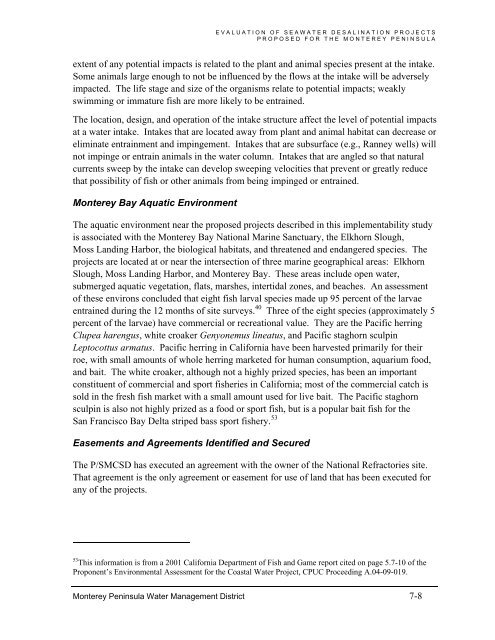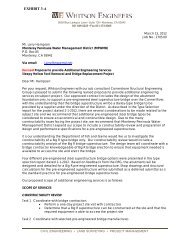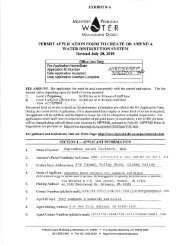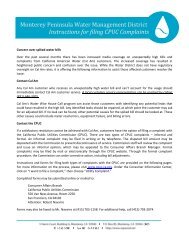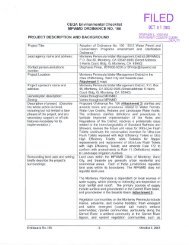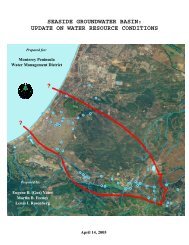FINAL REPORT Evaluation of Seawater Desalination Projects ...
FINAL REPORT Evaluation of Seawater Desalination Projects ...
FINAL REPORT Evaluation of Seawater Desalination Projects ...
Create successful ePaper yourself
Turn your PDF publications into a flip-book with our unique Google optimized e-Paper software.
EVALUATION OF SEAWATER DESALINATION PROJECTS<br />
PROPOSED FOR THE MONTEREY PENINSULA<br />
extent <strong>of</strong> any potential impacts is related to the plant and animal species present at the intake.<br />
Some animals large enough to not be influenced by the flows at the intake will be adversely<br />
impacted. The life stage and size <strong>of</strong> the organisms relate to potential impacts; weakly<br />
swimming or immature fish are more likely to be entrained.<br />
The location, design, and operation <strong>of</strong> the intake structure affect the level <strong>of</strong> potential impacts<br />
at a water intake. Intakes that are located away from plant and animal habitat can decrease or<br />
eliminate entrainment and impingement. Intakes that are subsurface (e.g., Ranney wells) will<br />
not impinge or entrain animals in the water column. Intakes that are angled so that natural<br />
currents sweep by the intake can develop sweeping velocities that prevent or greatly reduce<br />
that possibility <strong>of</strong> fish or other animals from being impinged or entrained.<br />
Monterey Bay Aquatic Environment<br />
The aquatic environment near the proposed projects described in this implementability study<br />
is associated with the Monterey Bay National Marine Sanctuary, the Elkhorn Slough,<br />
Moss Landing Harbor, the biological habitats, and threatened and endangered species. The<br />
projects are located at or near the intersection <strong>of</strong> three marine geographical areas: Elkhorn<br />
Slough, Moss Landing Harbor, and Monterey Bay. These areas include open water,<br />
submerged aquatic vegetation, flats, marshes, intertidal zones, and beaches. An assessment<br />
<strong>of</strong> these environs concluded that eight fish larval species made up 95 percent <strong>of</strong> the larvae<br />
entrained during the 12 months <strong>of</strong> site surveys. 40 Three <strong>of</strong> the eight species (approximately 5<br />
percent <strong>of</strong> the larvae) have commercial or recreational value. They are the Pacific herring<br />
Clupea harengus, white croaker Genyonemus lineatus, and Pacific staghorn sculpin<br />
Leptocottus armatus. Pacific herring in California have been harvested primarily for their<br />
roe, with small amounts <strong>of</strong> whole herring marketed for human consumption, aquarium food,<br />
and bait. The white croaker, although not a highly prized species, has been an important<br />
constituent <strong>of</strong> commercial and sport fisheries in California; most <strong>of</strong> the commercial catch is<br />
sold in the fresh fish market with a small amount used for live bait. The Pacific staghorn<br />
sculpin is also not highly prized as a food or sport fish, but is a popular bait fish for the<br />
San Francisco Bay Delta striped bass sport fishery. 53<br />
Easements and Agreements Identified and Secured<br />
The P/SMCSD has executed an agreement with the owner <strong>of</strong> the National Refractories site.<br />
That agreement is the only agreement or easement for use <strong>of</strong> land that has been executed for<br />
any <strong>of</strong> the projects.<br />
53 This information is from a 2001 California Department <strong>of</strong> Fish and Game report cited on page 5.7-10 <strong>of</strong> the<br />
Proponent’s Environmental Assessment for the Coastal Water Project, CPUC Proceeding A.04-09-019.<br />
Monterey Peninsula Water Management District 7-8


